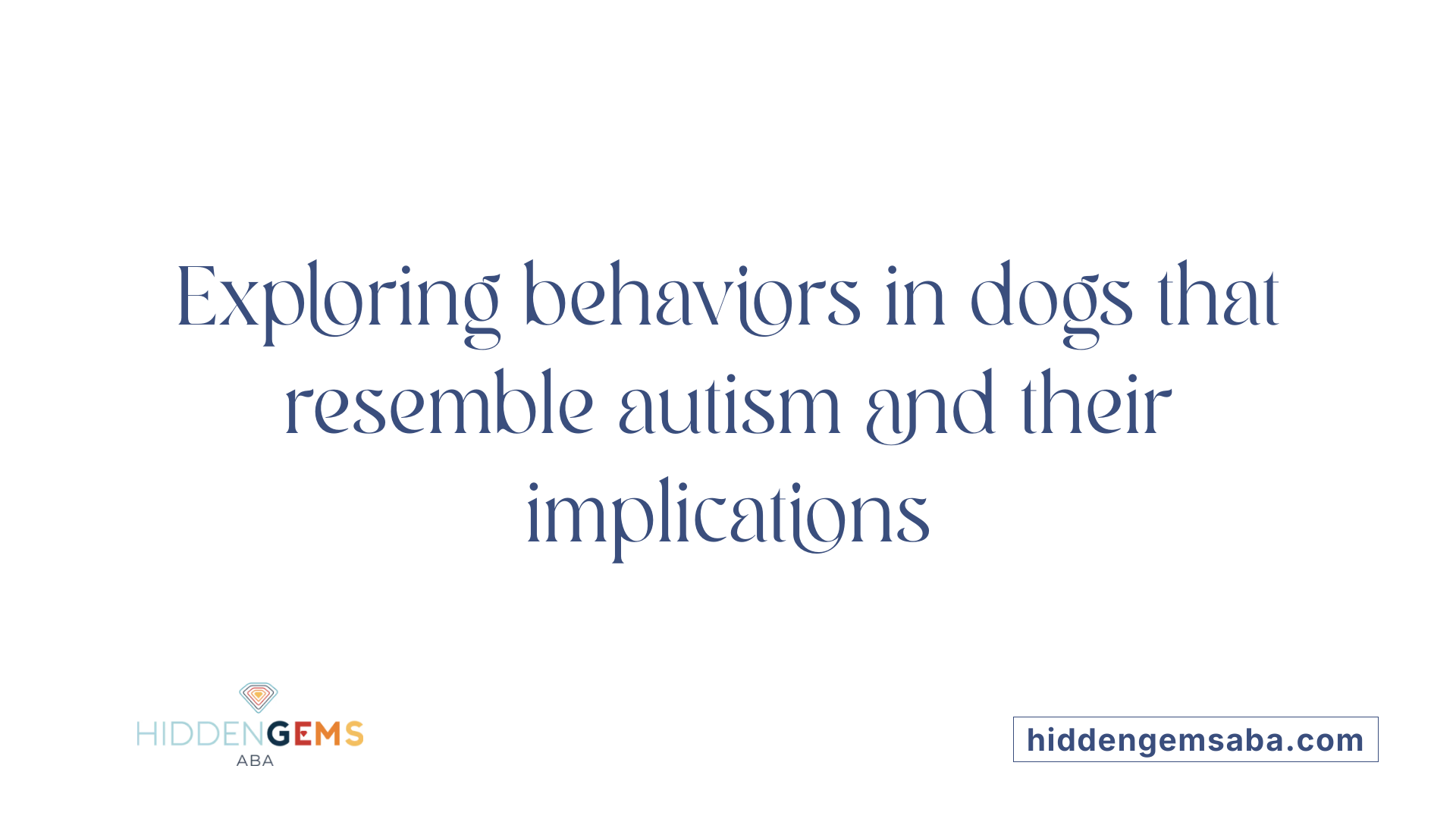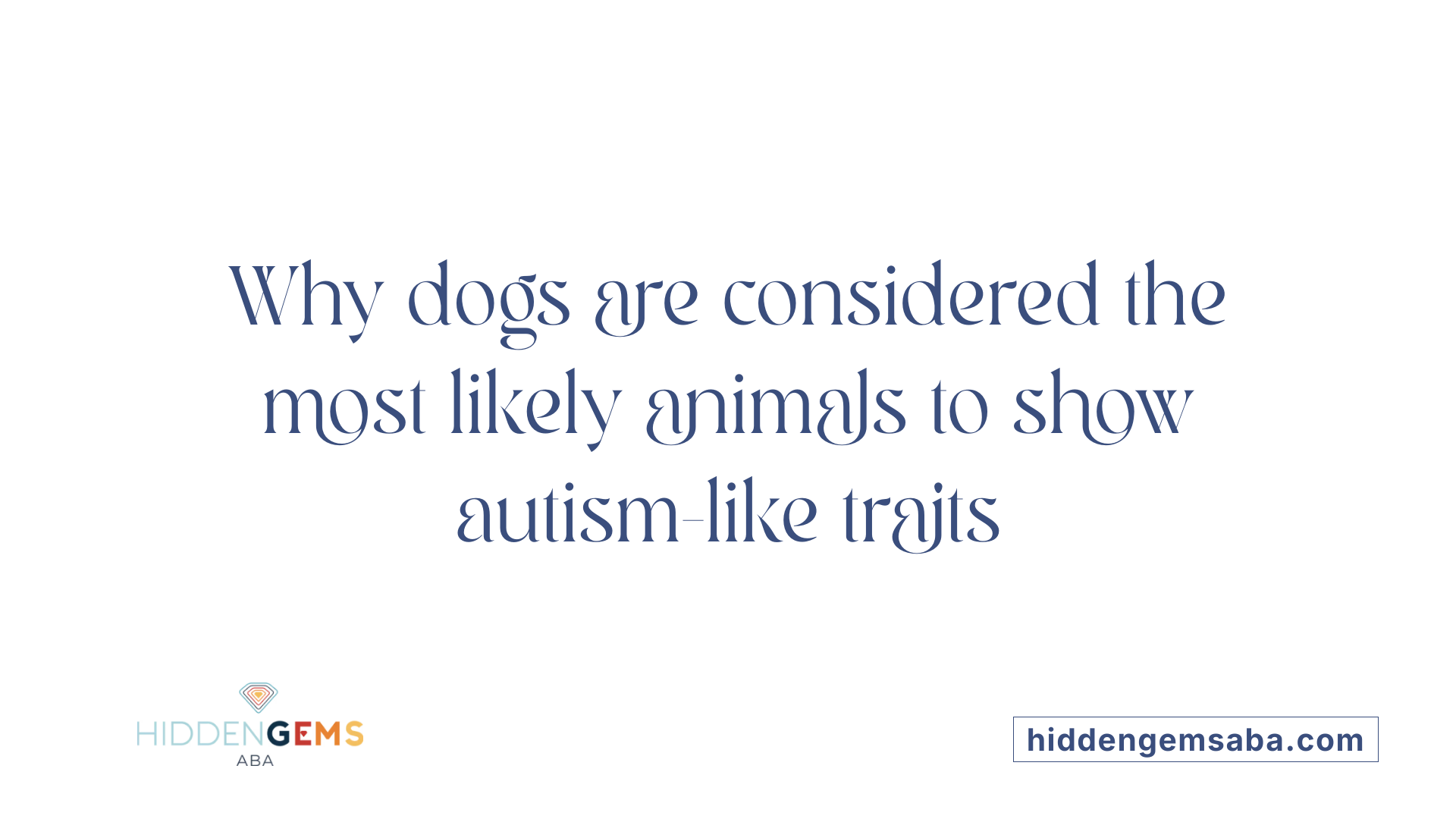Understanding Autism-like Traits Across Species
While autism is a neurodevelopmental condition unique to humans, various animal species display behaviors that resemble some characteristics of autism spectrum disorder (ASD). These behaviors include social withdrawal, repetitive actions, and sensory sensitivities, which are of great interest to researchers aiming to understand the biological and environmental factors underlying ASD. This article explores which animals can exhibit autism-like behaviors, the use of different species as models in research, and the significance of these studies in advancing our understanding of autism.
Animals Showing Autism-Like Behaviors but Not Diagnosed with Autism

What animals can be diagnosed with autism?
Currently, there are no animals definitively diagnosed with autism in the same way humans are. However, certain species such as rodents, dogs, and non-human primates can exhibit behaviors that resemble autism spectrum disorders, including social withdrawal, repetitive actions, and difficulty adapting to environmental changes.
These behaviors are often influenced by environmental factors like housing conditions, social interactions, and stress levels, which can affect their mental and behavioral health. In research settings, variations in environmental parameters can lead to changes in behavior that mimic autistic traits, making these animals valuable models for studying related neurodevelopmental conditions.
It is important to understand that while these animals show behaviors similar to autism, they are not actually diagnosed with the disorder. Instead, they serve as models to explore the neurological and behavioral characteristics associated with autism in humans.
Such animal models help scientists investigate the underlying biological mechanisms and test potential treatments. For example, mice lacking the gene for oxytocin display social deficits, and environmental models like maternal immune activation in rodents induce autism-like behaviors.
Despite the similarities, human clinical diagnosis of autism involves complex social, communicative, and behavioral assessments that cannot be directly applied to animals. Therefore, animals exhibiting autism-like traits are regarded as useful models rather than diagnosed cases of the condition.
Can Dogs Have Autism?

Do dogs exhibit behaviors similar to autism?
While dogs cannot be formally diagnosed with autism, some animal behaviors resemble symptoms seen in humans with autism spectrum disorder (ASD). These behaviors may include social withdrawal, repetitive movements like tail chasing, or heightened sensitivity to stimuli. For example, bull terriers are known for repetitive tail chasing, which has been compared to stereotyped behaviors in autistic children.
Research indicates that certain genetic and environmental factors influence these behaviors. Nonetheless, these traits in dogs are generally considered breed-specific or related to individual temperament rather than a true neurodevelopmental disorder like autism.
How do behaviors in dogs compare to human autism?
The main difference lies in the neurological basis. Human autism involves complex brain development issues that are specific to humans. Dogs and other animals can demonstrate behaviors that are superficially similar, but they do not exhibit the same social communication deficits or cognitive patterns involved in human autism.
Dogs are often more receptive to social cues and can form strong bonds with humans. Interestingly, autistic individuals tend to prefer interactions with animals over humans because animals provide clear and predictable social cues. This parallel has led to increased interest in using animals for therapeutic purposes rather than diagnosing their behaviors.
In summary, although dogs display behaviors that resemble some autistic traits, they cannot be diagnosed with autism. These behaviors are better understood within the contexts of breed traits, personality, or environmental influences rather than as symptoms of a neurodevelopmental disorder.
Most Likely Animals to Exhibit Autism-Like Behaviors

What animal is most likely to exhibit autism-like behaviors?
Among animals, dogs are considered the most likely to show behaviors similar to those seen in autism spectrum disorder (ASD) in humans. Some dogs develop what is known as canine dysfunctional behavior (CDB), which includes social withdrawal, obsessive actions, hyperactivity, and difficulties with sensory processing. These traits mirror many core features of ASD in humans.
While cats do not typically display autism, they can sometimes exhibit unusual behaviors due to developmental issues or stress, which are not directly comparable to ASD.
In addition to companion animals, various research models utilize animals like rodents (mice and rats), fruit flies, and sea hares. These models are valuable for scientific investigations because of their genetic manipulability and observable behaviors. They help researchers understand the biological and genetic factors of ASD and evaluate potential treatments.
Overall, dogs stand out as the animal most naturally exhibiting behaviors akin to autism, making them especially relevant for both research and therapeutic contexts.
Can Animals Have Other Neurodevelopmental Conditions?
Animals can display behaviors that resemble certain human psychiatric symptoms. For example, some birds show obsessive actions, horses may develop compulsive behaviors, and dolphins or whales sometimes self-mutilate. These behaviors can be seen as parallels to specific mental health issues.
However, genuine conditions like schizophrenia have not been identified outside of humans. The development of schizophrenia is believed to be linked to the complexity of the human brain and certain genetic factors unique to humans. Human-specific genetic regions known as human accelerated regions (HARs) influence genes involved in cognition and language, making schizophrenia a uniquely human disorder.
While animals—especially domesticated species like dogs—can experience anxiety, depression, obsessive-compulsive disorder (OCD), and attention-deficit/hyperactivity disorder (ADHD)-like behaviors, these do not encompass the full spectrum of human psychosis. Such behaviors are often considered models to understand certain aspects of human mental health but do not fully replicate the psychotic features or neurobiological underpinnings of human schizophrenia.
Overall, current scientific understanding suggests that true neurodevelopmental and mental health disorders such as schizophrenia are exclusive to humans. The complexity of human cognition, language, and brain structure plays a significant role in this. Although animals can serve as models to study aspects of neurodevelopmental disorders, they do not develop these conditions in the same way humans do, highlighting the uniqueness of certain psychiatric illnesses.
Biological and Behavioral Parallels Between Animals and Humans with Autism
Do animals display autistic-like traits such as repetitive behaviors or atypical social habits?
Yes, certain animal species exhibit behaviors that resemble some features of autism in humans. For example, bull terriers are known for tail chasing, a repetitive action similar to the repetitive behaviors seen in autistic children. In the wild, some birds like zebra finches display communication patterns and social habits that can serve as models for understanding ASD.
In laboratory settings, rodents such as mice and rats are used extensively to study these traits. They can demonstrate repetitive movements, social interaction deficits, and sensory processing irregularities. Some gene mutations linked to autism, like those in Fmr1 or MECP2, produce behaviors in mice that closely mimic core autistic traits.
Research involving animal models helps researchers explore the biological mechanisms behind these behaviors. It also provides a platform to test potential therapeutics aimed at reducing repetitive behaviors and improving social skills, offering hope for better understanding and potentially treating autism in humans.
Research and Therapeutic Use of Animal Models in Autism
What types of animal models are used in autism research?
Scientists use various animals to study autism, aiming to understand its complex causes and develop potential treatments. Among these, rodents such as mice and rats are the most common because they are cost-effective and have advanced genetic tools. These models often incorporate gene mutations linked to autism, such as Fmr1, MECP2, and NLGN3, which help researchers observe how genetic factors influence behaviors associated with autism.
Other models include non-human primates like rhesus and cynomolgus monkeys, which share many genetic and behavioral features with humans. Although their use is more expensive, they provide closer insights into social behaviors and neurodevelopment.
Birds, particularly zebra finches, are studied to understand communication deficits often seen in autism. Zebrafish are also valuable due to their rapid development and transparent bodies, which facilitate genetic studies. Invertebrates like fruit flies (Drosophila) are used for genetic screening because of their genetic simplicity and manipulability.
Environmental factors are also modeled in animals, such as maternal immune activation through agents like Poly(I:C) or LPS injections in pregnant rodents. These approaches help mimic prenatal influences believed to contribute to autism.
How are these models used in pharmaceutical research and therapy?
Animal models serve as platforms to test new drugs and therapies. Researchers examine pharmaceuticals such as mTOR inhibitors, oxytocin, and probiotics to see if they can mitigate autism-like symptoms. For instance, mice lacking the oxytocin gene show social deficits that improve with oxytocin supplementation.
Therapeutic interventions with animals extend beyond drug testing. Service animals, including dogs trained to assist children with autism, can provide emotional support, improve safety, and promote social engagement. Animal-assisted therapy (AAT) with dogs, guinea pigs, or even horses has been shown to aid in increasing social skills, reducing anxiety, and decreasing feelings of isolation.
This comprehensive use of animal models helps advance our understanding of autism and paves the way for developing more effective treatments. By combining genetic, environmental, and therapeutic research, scientists aim to uncover better ways to support individuals on the autism spectrum.
| Animal Model Type | Primary Use | Notable Features | Additional Details |
|---|---|---|---|
| Rodents (mice, rats) | Genetic and environmental studies, drug testing | Cost-effective, genetic manipulation, behavioral observation | Fmr1, MECP2 mutations, maternal immune activation |
| Non-human primates | Complex behavioral studies, social behaviors | Similar brain and social structure to humans | Costly, used for advanced behavioral research |
| Birds (zebra finches) | Communication deficits, vocalization studies | Insights into speech and communication issues | Useful in neurodevelopmental research |
| Zebrafish | Developmental and genetic studies | Transparent, rapid development | Genetic conservation with humans |
| Fruit flies (Drosophila) | Genetic screening, molecular studies | Simple, highly manipulable | Conservation of many autism-related genes |
These models are instrumental in unraveling the biological and environmental factors of autism and in testing potential interventions, bringing hope for better therapies in the future.
The Human-Animal Bond and Autism Spectrum Benefits
How does pet therapy foster social and emotional benefits for autistic individuals?
Pet therapy, also known as animal-assisted therapy, is increasingly used to support children and adults on the autism spectrum. Interactions with animals such as dogs, guinea pigs, and even horses have shown to promote social skills, reduce feelings of isolation, and encourage communication.
What are the social advantages of animals for people with autism?
Many autistic individuals find it easier to connect with animals than with humans. Animals provide clear social cues without conflicting signals, which helps in making social interactions less overwhelming. Pet ownership or animal-assisted activities can act as bridges, helping individuals foster relationships within their families and communities.
How do animals help in stress reduction for autistic persons?
Interaction with pets offers sensory soothing and tactile comfort, which can calm anxious feelings. Studies show that human-animal exchanges increase serotonin levels, elevating mood and calming the nervous system.
Additional insights
Research indicates that about 80% of autistic children benefit from pet therapy, experiencing improvements in communication and emotional regulation. Pets can serve as confidantes and companions, providing a steady presence that encourages confidence and independence.
| Benefit Type | Description | Supporting Example |
|---|---|---|
| Social Skills | Enhances ability to interact and communicate | Dogs facilitating conversations in therapy |
| Stress Relief | Reduces anxiety and promotes mood stability | Calming effects of petting animals |
| Emotional Support | Provides comfort and companionship | Autistic children feeling less lonely |
| Confidence & Independence | Motivates caregiving and social engagement | Caring for a pet fostering responsibility |
Animals serve as catalysts for social and emotional growth, making the human-animal bond a valuable tool in autism support strategies.
How to Engage with Animals When Pet Ownership Is Not Feasible
 Fostering animals or volunteering at local shelters can be excellent ways for autistic individuals to benefit from the presence of animals without the responsibilities of ownership. Starting with smaller pets like guinea pigs or fish can provide sensory comfort and companionship.
Fostering animals or volunteering at local shelters can be excellent ways for autistic individuals to benefit from the presence of animals without the responsibilities of ownership. Starting with smaller pets like guinea pigs or fish can provide sensory comfort and companionship.
Seeking advice from experienced handlers or organizations can help newcomers learn how to care for and bond with animals. Participating in animal-assisted activities, such as equine therapy or visiting therapy dogs, can foster social interaction and reduce feelings of isolation.
Engagement with animals through volunteering or fostering offers emotional support, encourages independence, and helps develop empathy—all while accommodating those who face barriers to owning a pet.
The Value of Animal Research and Human-Animal Connections
Studying animal behaviors and utilizing animal models provide crucial insights into the biological and environmental influences on autism spectrum disorder. While animals cannot be diagnosed with autism in the clinical sense, their behaviors serve as valuable proxies for understanding the disorder's complexities. Moreover, the human-animal bond enriches the lives of autistic individuals, contributing to their mental health and social development. Continued research and compassionate engagement with animals hold promise for advancing therapies and improving the quality of life for those on the autism spectrum.
References
- Animal model of autism - Wikipedia
- Is autism found in any other animals? - BBC Science Focus Magazine
- Pet Ownership and Autism
- Modeling Autistic Features in Animals | Pediatric Research - Nature
- The Human-Animal Bond for Autism Spectrum Disorder | Blog | HABRI
- Understanding autism spectrum disorders with animal models
- What Is The Treetop ABA Therapy?
- Can Dogs Have Autism? Unpacking Dogs' Development

.avif)




